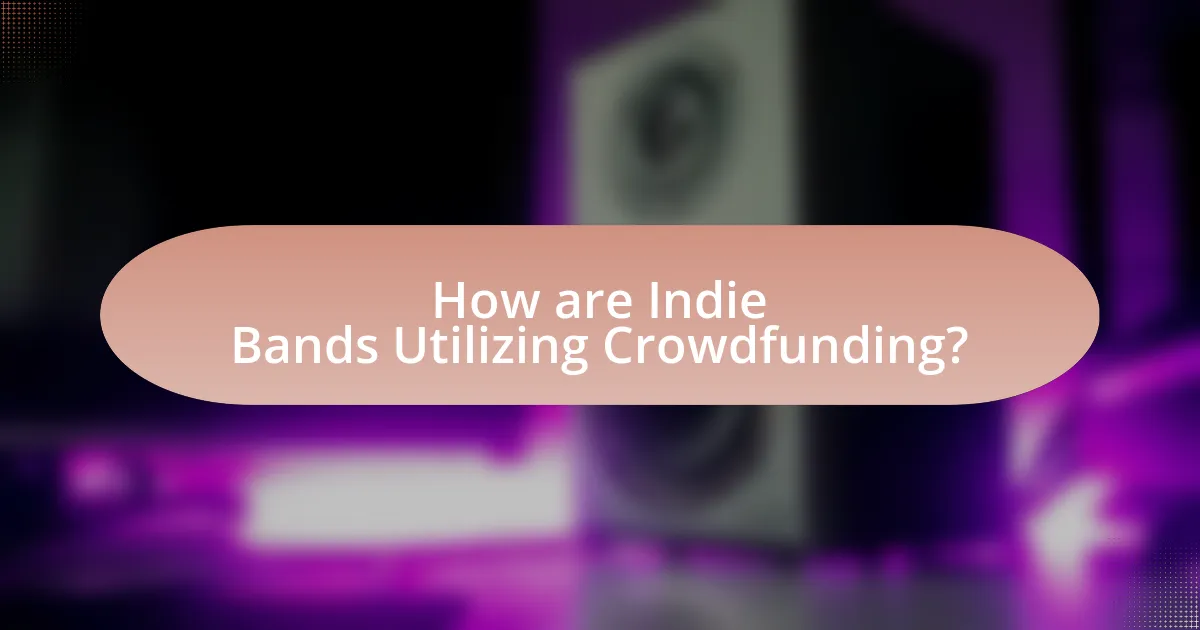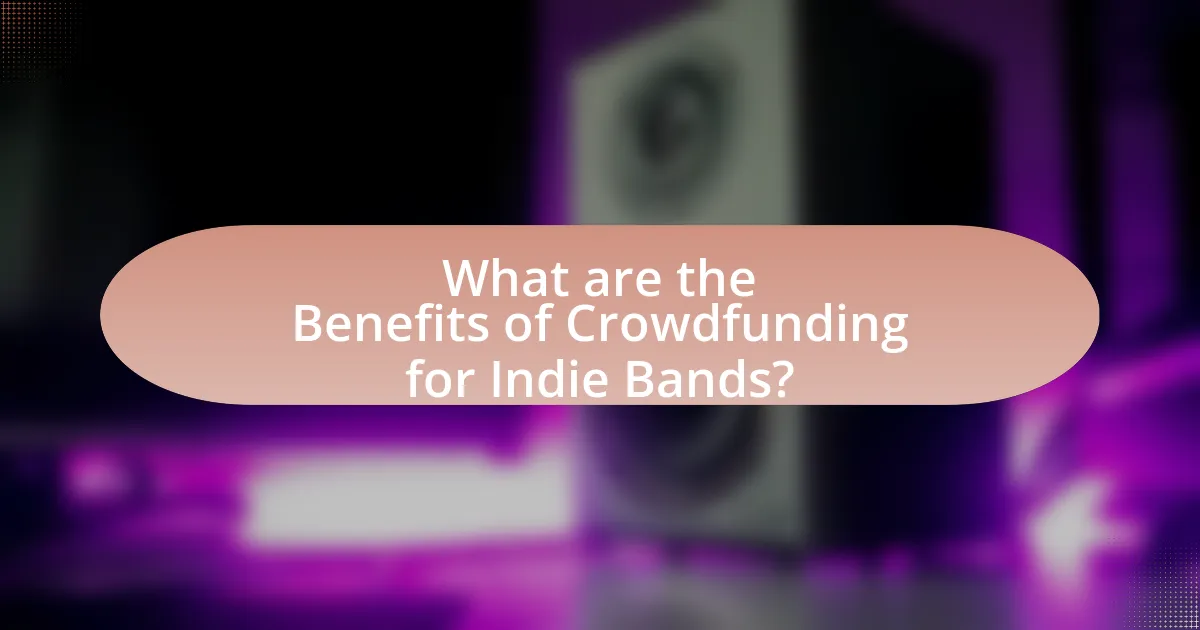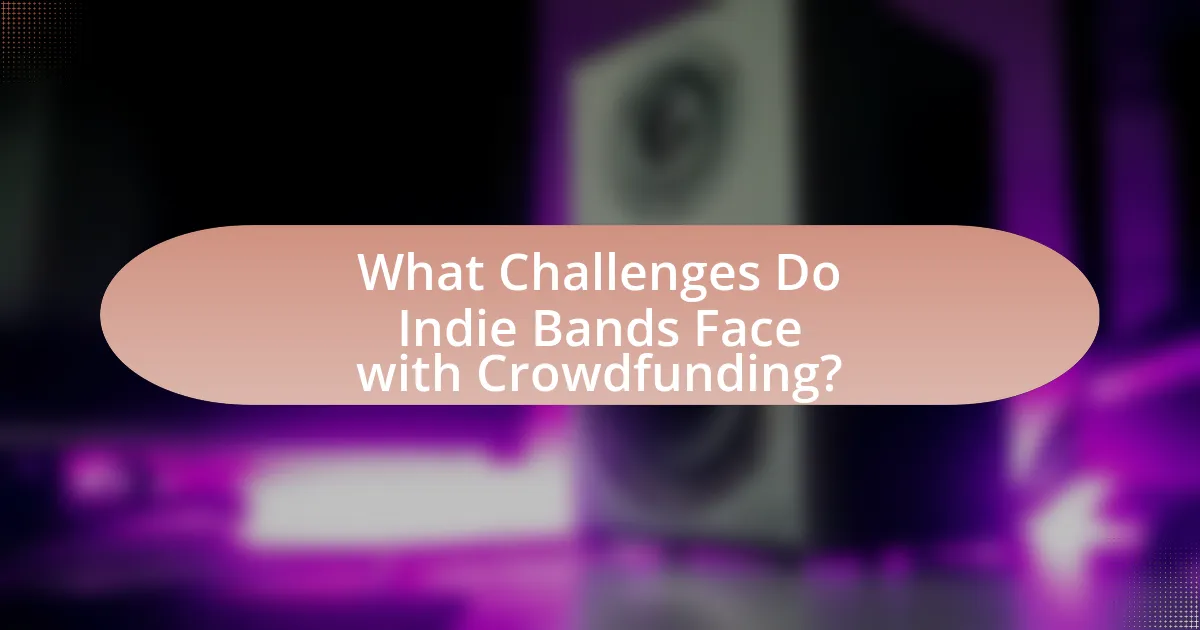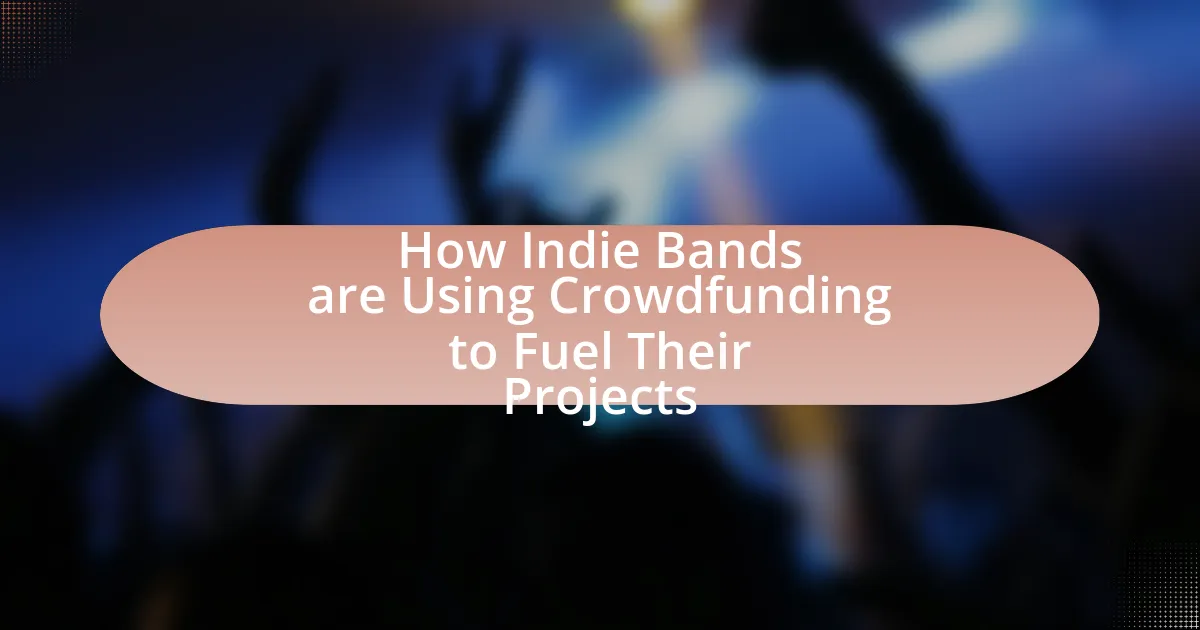Indie bands are increasingly turning to crowdfunding as a primary means of financing their music projects, including album production, tours, and merchandise. Utilizing platforms such as Kickstarter and Indiegogo, these artists engage directly with their fan base, allowing supporters to contribute financially in exchange for rewards. The article explores various crowdfunding platforms popular among indie bands, the differences in their features, and the strategies bands employ to successfully fund their projects. It also addresses the challenges indie bands face in securing traditional funding, the benefits of crowdfunding, and the importance of effective marketing and fan engagement in achieving funding goals. Additionally, the article highlights the legal and financial considerations indie bands must navigate while running crowdfunding campaigns.

How are Indie Bands Utilizing Crowdfunding?
Indie bands are utilizing crowdfunding primarily to finance their music projects, including album production, tours, and merchandise. By leveraging platforms like Kickstarter and Indiegogo, these bands can directly engage with their fan base, allowing supporters to contribute financially in exchange for rewards such as exclusive content or early access to new music. In 2020, a study by the Berklee College of Music found that 38% of musicians reported using crowdfunding as a significant source of income, highlighting its effectiveness in the indie music scene. This approach not only provides necessary funds but also fosters a sense of community and investment among fans, enhancing the band’s relationship with their audience.
What types of crowdfunding platforms are popular among indie bands?
Indie bands commonly utilize reward-based crowdfunding platforms, equity crowdfunding platforms, and donation-based crowdfunding platforms. Reward-based platforms like Kickstarter and Indiegogo allow bands to offer incentives such as exclusive merchandise or concert tickets in exchange for financial support. Equity crowdfunding platforms, such as SeedInvest, enable bands to offer shares in their projects, appealing to investors looking for a stake in the music industry. Donation-based platforms like GoFundMe allow fans to contribute without expecting anything in return, often used for specific projects or emergencies. These platforms have gained popularity due to their accessibility and the ability to directly engage with fans, facilitating funding for music production, tours, and promotional activities.
How do these platforms differ in terms of features and audience?
Crowdfunding platforms for indie bands differ significantly in features and audience. For instance, Kickstarter focuses on project-based funding with an all-or-nothing model, appealing to creators who want to launch specific projects, while Indiegogo offers flexible funding options, allowing creators to keep funds raised even if they don’t meet their goal, attracting a broader range of projects. Additionally, Patreon emphasizes subscription-based funding, catering to artists seeking ongoing support from fans, which fosters a community-oriented audience. These distinctions in funding models and target demographics influence how indie bands engage with their supporters and structure their campaigns.
What are the most successful crowdfunding platforms for music projects?
The most successful crowdfunding platforms for music projects are Kickstarter, Indiegogo, and Patreon. Kickstarter has funded over 200,000 music projects, raising more than $1 billion since its inception, making it a leading choice for musicians. Indiegogo offers flexible funding options and has supported numerous successful music campaigns, while Patreon allows artists to receive ongoing support from fans through subscriptions, fostering a sustainable income model. These platforms have proven effective in helping indie bands and musicians finance their projects and connect with their audience.
Why are indie bands turning to crowdfunding instead of traditional funding?
Indie bands are turning to crowdfunding instead of traditional funding primarily due to greater financial autonomy and direct fan engagement. Crowdfunding platforms like Kickstarter and Indiegogo allow musicians to raise funds directly from their supporters, eliminating the need for intermediaries such as record labels or banks, which often impose restrictive contracts and high-interest loans. According to a 2020 study by the University of Southern California, 38% of musicians reported that crowdfunding provided them with more creative control over their projects compared to traditional funding methods. This shift not only empowers artists but also fosters a community-driven approach, where fans feel invested in the success of the band, leading to a more sustainable financial model.
What challenges do indie bands face in securing traditional funding?
Indie bands face significant challenges in securing traditional funding primarily due to a lack of established track records and industry connections. Traditional funding sources, such as record labels and banks, often require proven sales history or substantial collateral, which many indie bands do not possess. Additionally, the competitive nature of the music industry makes it difficult for these bands to stand out and attract the attention of potential investors. According to a 2020 study by the Music Industry Research Association, 70% of indie musicians reported difficulties in accessing traditional funding due to these barriers.
How does crowdfunding provide a solution to these challenges?
Crowdfunding provides a solution to the financial challenges faced by indie bands by enabling them to raise funds directly from their fan base. This method allows artists to bypass traditional funding sources, such as record labels or banks, which often impose strict requirements and lengthy processes. For instance, platforms like Kickstarter and Indiegogo have facilitated millions in funding for creative projects, with Kickstarter reporting over $5 billion pledged to various campaigns since its inception. By engaging their audience, indie bands can secure the necessary resources for recording, touring, and marketing, while also fostering a sense of community and loyalty among supporters.
What strategies do indie bands use to successfully crowdfund their projects?
Indie bands successfully crowdfund their projects by leveraging social media engagement, offering unique rewards, and building a strong community around their music. Social media platforms like Instagram and Facebook allow bands to connect directly with fans, share their creative process, and generate excitement about their crowdfunding campaigns. Offering unique rewards, such as exclusive merchandise, private concerts, or behind-the-scenes content, incentivizes fans to contribute financially. Additionally, fostering a sense of community through regular updates and interactions helps maintain momentum and encourages more contributions, as fans feel personally invested in the band’s success. These strategies have been validated by successful campaigns on platforms like Kickstarter and Indiegogo, where bands have raised significant funds by effectively engaging their audience.
How important is marketing in a crowdfunding campaign?
Marketing is crucial in a crowdfunding campaign, as it directly influences the visibility and funding success of the project. Effective marketing strategies can significantly increase the number of backers and the total funds raised. For instance, a study by the University of Pennsylvania found that campaigns with a strong marketing presence, including social media engagement and targeted outreach, raised 50% more than those without. This demonstrates that a well-executed marketing plan is essential for indie bands seeking to leverage crowdfunding for their projects.
What role does fan engagement play in the success of crowdfunding?
Fan engagement is crucial for the success of crowdfunding, as it directly influences the amount of financial support a project receives. Engaged fans are more likely to contribute to crowdfunding campaigns, as they feel a personal connection to the project and its creators. Research indicates that campaigns with higher levels of fan interaction, such as updates and direct communication, tend to achieve funding goals more effectively. For instance, a study by the University of Pennsylvania found that projects with active backer engagement raised 50% more funds than those with minimal interaction. This demonstrates that fostering a strong relationship with fans not only enhances emotional investment but also translates into tangible financial support for crowdfunding initiatives.

What are the Benefits of Crowdfunding for Indie Bands?
Crowdfunding provides indie bands with essential financial support, enabling them to produce music, fund tours, and promote their work without relying on traditional record labels. This funding model allows bands to connect directly with their fanbase, fostering a sense of community and loyalty. According to a 2020 study by the University of Southern California, 38% of successful crowdfunding campaigns for music projects exceeded their funding goals, demonstrating the effectiveness of this approach. Additionally, crowdfunding platforms like Kickstarter and Indiegogo have facilitated over $1 billion in funding for creative projects, highlighting the growing trend of artists leveraging this method to achieve their artistic visions.
How does crowdfunding help indie bands build a fanbase?
Crowdfunding helps indie bands build a fanbase by enabling direct financial support from fans, which fosters a sense of community and investment in the band’s success. This financial backing allows bands to produce music, merchandise, and live events, creating opportunities for engagement with supporters. For instance, platforms like Kickstarter and Indiegogo have facilitated successful campaigns for numerous indie bands, allowing them to raise funds while simultaneously promoting their music to a wider audience. As a result, bands can cultivate loyal followers who feel personally connected to the project, enhancing their overall fanbase.
What are the long-term benefits of engaging fans through crowdfunding?
Engaging fans through crowdfunding provides long-term benefits such as increased loyalty, a dedicated fanbase, and sustainable revenue streams. By involving fans in the funding process, indie bands create a sense of ownership and investment in the project, which fosters deeper emotional connections. Research indicates that projects with fan involvement often see higher retention rates, as fans who contribute financially are more likely to support future endeavors. Additionally, crowdfunding can lead to a reliable income source, as successful campaigns can establish a pattern of support that bands can leverage for future projects, enhancing their financial stability over time.
How can crowdfunding campaigns enhance an indie band’s visibility?
Crowdfunding campaigns can enhance an indie band’s visibility by providing a platform for direct engagement with fans and potential supporters. These campaigns allow bands to showcase their music, share their stories, and connect with audiences on a personal level, which can lead to increased awareness and interest. For instance, successful crowdfunding efforts often result in social media buzz and word-of-mouth promotion, as backers share the campaign with their networks. Additionally, platforms like Kickstarter and Indiegogo have built-in communities that can expose the band to new listeners who are actively seeking unique projects to support. According to a study by the University of Southern California, campaigns that effectively engage their audience can see a 50% increase in social media followers during the funding period, demonstrating the tangible impact of crowdfunding on visibility.
What financial advantages does crowdfunding offer to indie bands?
Crowdfunding offers indie bands significant financial advantages, primarily by providing access to capital without the need for traditional loans or record label funding. This method allows bands to raise funds directly from their fanbase, which can lead to a more engaged audience and a sense of community support. For instance, successful crowdfunding campaigns can generate thousands of dollars; in 2020, the average amount raised by music projects on Kickstarter was approximately $5,000, demonstrating the potential for substantial financial backing. Additionally, crowdfunding enables bands to retain full ownership of their music and creative direction, as they are not beholden to external investors or labels. This financial model empowers indie bands to finance recording, touring, and merchandise production while fostering a loyal fanbase that feels invested in their success.
How does crowdfunding reduce financial risk for indie bands?
Crowdfunding reduces financial risk for indie bands by allowing them to secure funding upfront before incurring significant expenses. This model enables bands to gauge interest in their projects and receive financial support directly from fans, minimizing the need for loans or personal investments. For instance, a successful crowdfunding campaign can raise thousands of dollars, as seen in cases like Amanda Palmer, who raised over $1.2 million on Kickstarter for her album, demonstrating that direct fan investment can cover production costs and reduce reliance on traditional funding sources.
What are the potential returns on investment for backers of indie bands?
Backers of indie bands can potentially see returns on investment through revenue generated from music sales, merchandise, and live performances. For instance, successful crowdfunding campaigns can lead to increased album sales, with some indie bands reporting sales growth of up to 300% post-campaign. Additionally, backers may receive exclusive rewards such as limited edition merchandise or VIP concert experiences, which can enhance their overall investment value. Furthermore, if an indie band gains significant popularity, early investors may benefit from future revenue streams, including licensing deals and streaming royalties, which can yield substantial financial returns over time.
How does crowdfunding foster creativity and artistic freedom for indie bands?
Crowdfunding fosters creativity and artistic freedom for indie bands by providing them with financial resources directly from their fanbase, allowing them to pursue unique projects without the constraints of traditional funding sources. This model enables bands to maintain creative control over their music and artistic direction, as they are not beholden to record labels or investors who may impose commercial pressures. For instance, a study by the University of Southern California found that 60% of musicians who used crowdfunding reported feeling more empowered to create music that reflects their true artistic vision. This financial independence encourages experimentation and innovation, leading to diverse musical expressions that resonate with their audience.
In what ways does crowdfunding allow for more diverse projects?
Crowdfunding enables more diverse projects by providing access to funding for creators who may not fit traditional funding models. This democratization of financial support allows indie bands, for example, to present unique musical styles and concepts that might be overlooked by mainstream investors. According to a study by the University of Pennsylvania, crowdfunding platforms have facilitated over $34 billion in funding globally, showcasing a wide array of creative projects, including niche genres and experimental music. This financial inclusivity empowers artists from various backgrounds to share their work, ultimately enriching the cultural landscape.
How can indie bands maintain creative control through crowdfunding?
Indie bands can maintain creative control through crowdfunding by directly engaging their fanbase to fund projects without relying on traditional record labels. This model allows bands to set their own terms, retain ownership of their music, and make artistic decisions without external pressures. For instance, successful crowdfunding platforms like Kickstarter and Indiegogo enable artists to present their vision and receive financial backing from supporters who believe in their work, thus fostering a community-driven approach. According to a 2020 study by the University of Southern California, 64% of musicians reported that crowdfunding helped them preserve their artistic integrity by allowing them to bypass industry gatekeepers.

What Challenges Do Indie Bands Face with Crowdfunding?
Indie bands face several challenges with crowdfunding, including limited visibility, competition, and the need for effective marketing strategies. Limited visibility arises because many indie bands lack established fan bases, making it difficult to attract backers. Competition is fierce, as numerous projects vie for attention on crowdfunding platforms, often leading to donor fatigue. Additionally, indie bands must develop compelling marketing strategies to engage potential supporters, which can be resource-intensive and require skills that may not be inherent to the musicians. These challenges can hinder the success of crowdfunding campaigns, as evidenced by studies showing that only about 30% of music-related crowdfunding projects reach their funding goals.
What common pitfalls should indie bands avoid in crowdfunding campaigns?
Indie bands should avoid several common pitfalls in crowdfunding campaigns, including setting unrealistic funding goals. Many campaigns fail because bands overestimate their fanbase’s willingness to contribute, leading to disappointment and a lack of funds. Additionally, neglecting to create a compelling narrative can hinder engagement; campaigns that tell a story about the project often attract more backers. Poor communication with supporters is another critical mistake; regular updates and transparency build trust and encourage ongoing support. Lastly, failing to offer attractive rewards can deter potential backers; research shows that well-structured reward tiers significantly increase funding success.
How can poor planning impact the success of a crowdfunding campaign?
Poor planning can significantly hinder the success of a crowdfunding campaign by leading to inadequate funding goals, ineffective marketing strategies, and mismanagement of resources. For instance, if an indie band sets a funding goal without thoroughly assessing their project costs, they may fall short of the necessary funds to complete their album or tour. Additionally, a lack of a clear marketing plan can result in low visibility and engagement, as seen in a study by the University of Pennsylvania, which found that campaigns with structured outreach strategies raised 50% more than those without. Furthermore, poor resource management can lead to delays and unmet deadlines, damaging the band’s reputation and trust with backers.
What are the consequences of not meeting funding goals?
Not meeting funding goals can lead to significant setbacks for indie bands relying on crowdfunding. These consequences include the inability to produce music, resulting in delayed album releases or canceled projects, which can harm the band’s reputation and fan engagement. Additionally, insufficient funds may limit marketing efforts, reducing visibility and potential audience reach. According to a study by the University of Southern California, 60% of crowdfunding campaigns that fail to meet their goals do not proceed with their intended projects, highlighting the critical impact of funding shortfalls on project viability.
How do indie bands handle the pressure of delivering on crowdfunding promises?
Indie bands manage the pressure of delivering on crowdfunding promises by maintaining transparent communication with their backers and setting realistic expectations. They often provide regular updates on project progress, which helps build trust and keeps supporters engaged. According to a study by the University of Southern California, successful crowdfunding campaigns often involve consistent interaction with backers, which can lead to higher satisfaction rates among supporters. Additionally, many indie bands create tiered reward systems that incentivize backers while allowing the bands to fulfill promises in manageable increments. This structured approach helps mitigate the stress associated with meeting crowdfunding goals.
What strategies can bands implement to manage backer expectations?
Bands can manage backer expectations by maintaining clear and consistent communication throughout the crowdfunding process. This involves providing regular updates on project progress, setting realistic timelines for deliverables, and being transparent about any challenges encountered. For instance, a study by the University of Pennsylvania found that projects with frequent updates are 20% more likely to meet their funding goals, indicating that backers appreciate being kept informed. Additionally, bands should establish clear reward tiers that accurately reflect the value of what backers will receive, ensuring that expectations align with the actual offerings. By implementing these strategies, bands can foster trust and satisfaction among their supporters.
How important is communication with backers during and after the campaign?
Communication with backers during and after the campaign is crucial for the success of crowdfunding efforts by indie bands. Effective communication fosters trust, keeps backers informed about project developments, and encourages ongoing support. Research indicates that campaigns with regular updates and transparent communication achieve higher funding success rates, as backers feel more engaged and valued. For instance, a study by the University of Pennsylvania found that projects with frequent updates raised 126% more funds than those with infrequent communication. This highlights the importance of maintaining a strong connection with backers throughout the crowdfunding process.
What legal and financial considerations should indie bands be aware of?
Indie bands should be aware of copyright laws, contract agreements, and financial management practices. Copyright laws protect original music and lyrics, ensuring that bands retain ownership and can monetize their work. Contract agreements, including those with producers, venues, and crowdfunding platforms, outline the terms of collaboration and revenue sharing, which are crucial for avoiding disputes. Financial management practices, such as budgeting for recording, marketing, and touring expenses, are essential for sustaining operations and maximizing crowdfunding efforts. According to the U.S. Copyright Office, registering a copyright can provide legal advantages in case of infringement, reinforcing the importance of understanding these legal frameworks.
What are the tax implications of crowdfunding for indie bands?
Crowdfunding for indie bands typically results in taxable income, as funds received are generally considered contributions or revenue. The Internal Revenue Service (IRS) mandates that any money raised through crowdfunding platforms, such as Kickstarter or Indiegogo, must be reported as income on tax returns. This classification applies unless the funds are classified as gifts, which is rare and subject to specific conditions. For instance, if a band offers rewards or incentives in exchange for contributions, the IRS views these transactions as sales, further solidifying the income tax obligation. Additionally, expenses incurred during the crowdfunding campaign can be deducted, provided they are directly related to the band’s business activities. Therefore, indie bands must maintain accurate records of both income and expenses to comply with tax regulations.
How can bands protect their intellectual property during crowdfunding?
Bands can protect their intellectual property during crowdfunding by registering their works with copyright offices and using clear licensing agreements. Registering music, lyrics, and artwork provides legal recognition and protection against unauthorized use. Additionally, bands should outline specific terms in their crowdfunding campaigns, detailing how their intellectual property can be used by backers, which helps prevent misuse. According to the U.S. Copyright Office, registration not only establishes a public record of the copyright but also allows for statutory damages and attorney fees in case of infringement.
What are the best practices for running a successful crowdfunding campaign?
The best practices for running a successful crowdfunding campaign include setting a clear funding goal, creating a compelling story, and engaging with potential backers. A clear funding goal helps backers understand the financial needs of the project, while a compelling story captures their interest and emotional investment. Engaging with potential backers through regular updates and personal interactions fosters a sense of community and encourages support. Research indicates that campaigns with a well-defined narrative and active communication can increase funding success rates by up to 50%.
How can indie bands effectively promote their crowdfunding campaigns?
Indie bands can effectively promote their crowdfunding campaigns by leveraging social media platforms, engaging with their fanbase, and creating compelling content. Social media allows bands to reach a wider audience; for instance, platforms like Instagram and Facebook have billions of active users, providing a vast potential reach. Engaging with fans through regular updates, behind-the-scenes content, and personal stories fosters a sense of community and investment in the project. Additionally, creating high-quality promotional materials, such as videos and graphics, can significantly enhance the campaign’s appeal. Research indicates that campaigns with engaging visuals are 94% more likely to be shared, increasing visibility and support.
What tips can help indie bands engage their audience throughout the campaign?
Indie bands can engage their audience throughout a crowdfunding campaign by maintaining consistent communication and offering exclusive content. Regular updates via social media and email newsletters keep fans informed and involved, fostering a sense of community. Additionally, providing backers with unique rewards, such as behind-the-scenes access or personalized merchandise, enhances their investment in the project. Research indicates that campaigns with frequent updates see a 50% higher success rate, demonstrating the importance of engagement in crowdfunding efforts.


